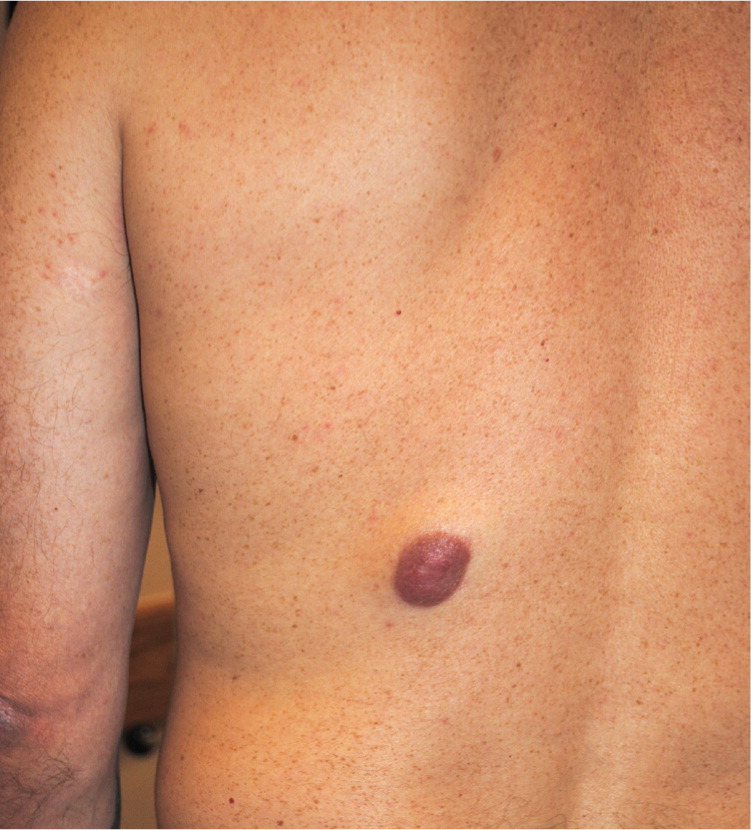
Am Fam Physician. 2013;87(6):439-440
Author disclosure: No relevant financial affiliations.
A 45-year-old man presented with a mass on his back that first appeared three or four years earlier. It had been growing steadily, and was becoming increasingly painful. He was taking etanercept (Enbrel) for rheumatoid arthritis.
Physical examination revealed a slightly raised, homogeneously pigmented, well-demarcated skin lesion on his midback (Figures 1 and 2). It measured 2 × 3 cm on the surface, with a subcutaneous mass that was two to three times larger. The mass was not fluctuant or warm, and was fixed to surrounding subcutaneous tissue.


Question
Discussion
The answer is A: Dermatofibrosarcoma protuberans is an uncommon, slow-growing, and locally aggressive tumor of the deep dermis. Dermatofibrosarcoma protuberans presents clinically as a nodular or multinodular mass, at least 4 cm in diameter. It usually appears on the trunk or lower extremities. The epidermis overlying the tumor may appear normal, hyperplastic, atrophic, or ulcerated. The tumor can also extend downward through the subcutaneous fat and along the fascial planes.1
Kaposi sarcoma is a slow-growing tumor of mesenchymal origin, with vascular and spindle cell components. It commonly occurs in persons with AIDS. Kaposi sarcoma initially presents as violaceous macules, usually on the distal lower extremities. As the disease progresses, the tumors enlarge and coalesce, forming spongy, purple-red nodules. In the later stages, lymph nodes and internal organs may become involved.3
Mycosis fungoides (cutaneous T-cell lymphoma) typically presents as pruritic, erythematous patches on the trunk that appear eczematous. Over time, a plaque stage may develop, involving lesions more than 5 cm in diameter that become rubbery and nodular, which may affect the face and scalp. In advanced cases, large tumors with epidermal ulceration may be associated with localized or generalized lymphadenopathy (lymphoma).4
Nodular malignant melanoma is usually invasive at the time of diagnosis. It arises rapidly over one to two years and commonly originates de novo from normal skin. It can present as an evenly raised, “blueberry-like” nodule; a polypoid lesion; or an ulcerated or thick plaque. The color varies but is often black.5
Sebaceous cysts are epithelial-lined cysts that typically result from the plugging of pilosebaceous units and are common in adults. The cyst often has a punctum from which cheese-like debris may be expressed. An infection is suspected if the cyst becomes painful, inflamed, or purulent. In these cases, complete excision should be delayed until the inflammation has diminished.6 It is at this time that these cysts are observed to be associated with reddened and attenuated epidermis.

| Condition | Characteristics |
|---|---|
| Dermatofibrosarcoma protuberans | Nodular/multinodular tumor arising from the deep dermis; slow-growing, locally aggressive; tumor can extend downward through the subcutaneous fat and along the fascial planes, as well as superficially into the epidermis, which subsequently may appear hyperplastic, atrophic, or ulcerated |
| Kaposi sarcoma | Slowly progressing tumor of mesenchymal origin, with vascular and spindle cell components; initially presents as violaceous macules, usually on the distal lower extremities; lesions enlarge and coalesce, forming spongy, purple-red nodules |
| Mycosis fungoides (cutaneous T-cell lymphoma) | Pruritic, erythematous patches on the trunk; a plaque stage may develop involving lesions more than 5 cm in diameter that become rubbery and nodular and may affect the face and scalp; large tumors with epidermal ulceration may occur in late stages |
| Nodular malignant melanoma | Evenly raised, “blueberry-like” nodule, polypoid lesion, or ulcerated or thick plaque; usually black in color; often invasive at the time of diagnosis |
| Sebaceous cyst | Epithelial-lined cyst; typically results from plugging of pilosebaceous units; a punctum from which cheese-like debris may be expressed is common |

